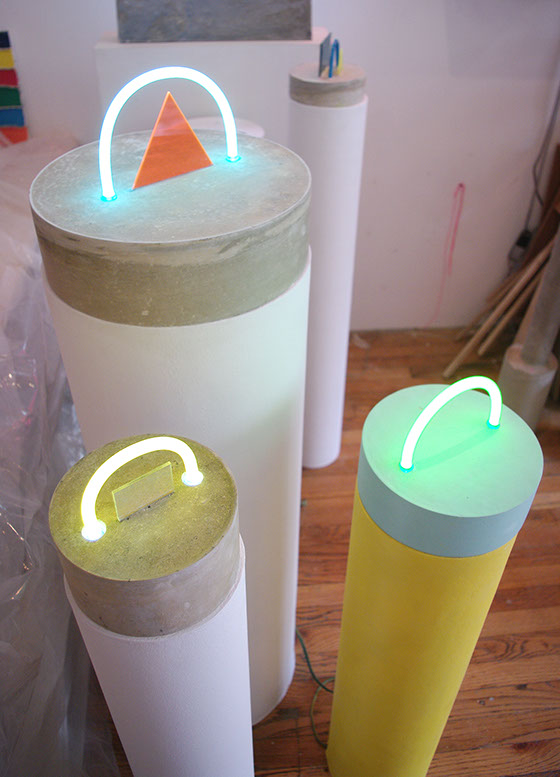
Sculptures in studio of Esther Ruiz
Photo: Scott Robinson 2014
Mark Epstein: The thing that hits me first with your work is the color. How do you arrive at the color schemes?
Esther Ruiz: I’ve always been attracted to fluorescent colors. I was working with them in undergrad. I think they come from pop culture and mass media and things that are made to attract us in some way and seduce us.
ME: Can you give me an example?
ER: Kitschy things. I really like refrigerator magnets and things that are silly and boring in some ways.
ME: That makes sense, the neon is so neon. It’s so good. It’s so there.
ER: Yeah (laugh)
ME: Is there any specific magnet that you go back to or anything specific that sits in your brain as a reference point?
ER: Not anything specific. I have lots of trinkets.
ME: You’ve got to tell us about a trinket now.
ER: Well, I have a ton of Star Wars trinkets.
ME: Really!?
ER: Yeah, I’m a big Star Wars nerd. And I like having those tiny little things around.
ME: You used the word seductive before. Are you trying to seduce the viewer and draw them in through the color?
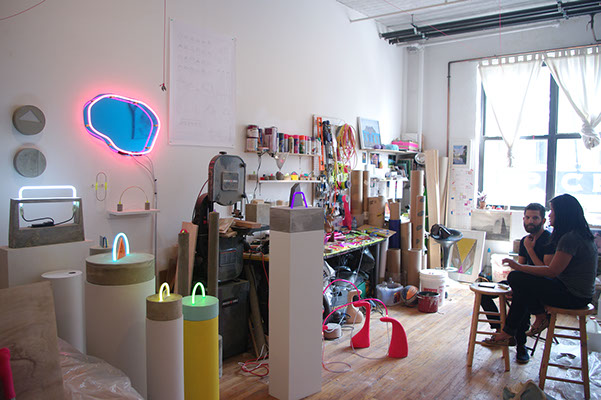
Mark Joshua Epstein (left) in conversation with Esther Ruiz (right) in the studio of Esther Ruiz
Photo: Scott Robinson 2014
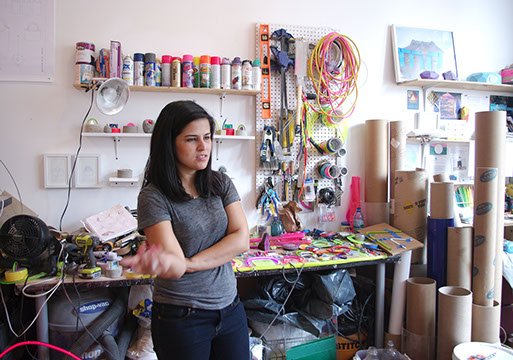
Esther Ruiz in her studio
Photo: Scott Robinson 2014
ER: No, not necessarily. That isn’t something I’m trying to do or thinking about doing, but I’m attracted to these colors and I’m drawn to them. I guess I’m seduced by them.
ME: And talk to me a little bit about the other materials that you’re using.
ER: So I first started using these really brightly colored pieces of Plexiglas. And then I started working at a neon shop. My first day there I was like “I’m going to use neon some day. I’m going to stick it in concrete”. So it came about naturally.
ME: Was it a neon shop for artists?
ER: We do make fine art. We make Glenn Ligon’s work, but we also make high-end retail displays and signs.
ME: Talk to me a little bit about the combination of neon, concrete, and Plexiglas.
ER: I don’t actually know how or why I started using them. It happened as soon as I moved to New York. And I think it was because I was/am surrounded by so much concrete. The very first one I made only had a semicircle piece of orange Plexiglas, it reminded me of the sunset. But, I feel like it’s just being in New York and being surrounded by industrial materials and soaking it all up. In some ways I feel like that’s what I’m doing, just soaking up a lot of stimuli.
ME: It’s funny because they also remind me of sonotubes. I was just reading an article in the New Yorker about the architect Shigeru Ban and he’s building houses out of similar paper tubes. So It’s interesting that you’re, I assume, casting inside them—is that how it’s working?
ER: Yeah.
ME: What’s your working time like when you use the concrete? How long do you have?
ER: A few minutes, like 5 to 10 minutes. I was using this super-fast setting concrete before and that gave me about three minutes, but now I’m using this hydraulic cement that has a longer working time. There’s a moment where the concrete —it’s only a few seconds— you kind of can feel it. It’ll get...
ME: It’ll seize up a bit.
ER: Yeah, and then there’s a moment where that’s it, and then it’s good.
ME: Has that ever meant something just didn’t work; where you thought, “screw this”?
ER: Oh yeah. There’s a pile of failures that I can’t fix because I want everything to be symmetrical and level and even. And if they’re not, they’re useless to me.
ME: Have you always been making things that were symmetrical, level and even?
ER: No, not really. In college I was making organically shaped things with the same colors but I wasn’t as anal or whatever.
ME: What happened?
ER: I don’t know. I guess its New York—I’m so stressed out all of the time.
ME: What other materials have you used in the past?
ER: I was using fabric in undergrad but I haven’t used that much. I’m adding more materials now, more recently, like thread. There’s thread in some glass tubes —and sand.
ME: Where does the sand come from?
ER: There’s this huge bag of it. I also have some sand I got from the Bahamas, but it’s a little bit different.
ME: When I look at the work —especially in person— I think the scale is really important, especially with these works on your shelf. For me, they read like non-art things: jewelry and graphic design, and also eighties furniture design from the Memphis group. Do you feel like you’re thinking more about contemporary life or do you have more historical things popping into your brain?
ER: I think it’s a juxtaposition of both; I initially started making them as core samples. These taller ones were the first two; I took a geology class my last semester of college and we studied core samples. I just think they’re fascinating in terms of telling time with the layers of sediment so, that’s where that started. There’s this aspect of something that’s thousands of years old that tells time but there’s also the Plexiglas that has more of a current vibe to it. It’s both of those things; I used to talk about them as core samples from the future or from another planet.
Finding this and not knowing where it’s from, it could look kind of… They look old because of the concrete but the neon is a futuristic type of thing or an outer space thing. I was thinking of them as core samples from other planets.
ME: I also think the concrete has this brutalist architectural history but it also refers to the developing world —exposed concrete when there’s nothing to cover it. So for me it really reads as polished and modernist but also kind of everyday and cheap.
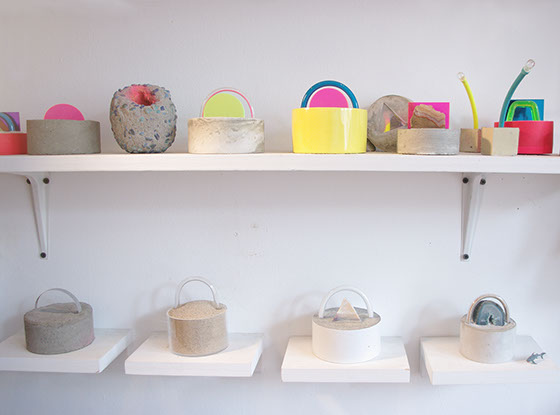
Sculptures on a shelf in the studio of Esther Ruiz
Photo: Scott Robinson 2014
ER: Yeah it’s really utilitarian.
ME: Talk to us about what’s in there to make the neon do what it’s doing.
ER: In the larger ones, there’s a hollow space that’s built into the mold which houses the transformer and wires. So at the end of the neon (tubes) there are electrodes and the electrodes are concocted to the transformer with a bit of wire. They’re all high voltage—the transformer takes 120v to like, some of those are 2000 volts, but they’re low amperage.
High voltage but low amperage; so they won’t kill you but they’ll definitely shock you
ME: Have you been shocked?
ER: Yes, nearly everyday but it’s not bad. It’s just like wow, a little jolt but it’s not bad.
ME: Are the drawings on the wall made by hand or with Illustrator?
ER: Illustrator. So now I make a drawing of each sculpture when they’re done.
ME: Not to say anything would be amiss in the sculptures, but if anything is, do you fix it in the drawing?
ER: Yeah (laugh) there are some sculptures that are oh, just a few millimeters off, but in illustrator you can make everything perfectly symmetrical.
ME: Does this carry over to other parts of your life? Is your apartment symmetrical? I’m just going to say your studio is not symmetrical.
ER: There are certain things I’m particular about. We won’t go into the OCD of my life, but I’m actually pretty messy... but I know where everything is.
ME: So the drawings happen after the sculptures. Does it feel like the sculpture is done when the drawing is made? Is it part of it or is it a separate practice?
ER: In some ways I feel like they’re completely resolved once the drawing is made.
ME: To me the drawings lend themselves so much to printmaking. But they also read like artists who are really interested in uniform lines like Michael Craig Martin and Patrick Caulfield. But you’re doing something very different because you’re not taking something and reducing it in the drawing like they are. You’re making a reduced thing and then doing a representational drawing of it.
ER: Yeah, in some ways. I call them an index. It’s like a checklist. This is what I’ve done.
ME: When one is out in the world and sees work like this that is so uniform and level and beautiful, it’s hard to imagine that there are broken ones. And then it’s harder to imagine
Mark Joshua Epstein (left) in conversation with Esther Ruiz (right) in the studio of Esther Ruiz
Photo: Scott Robinson 2014
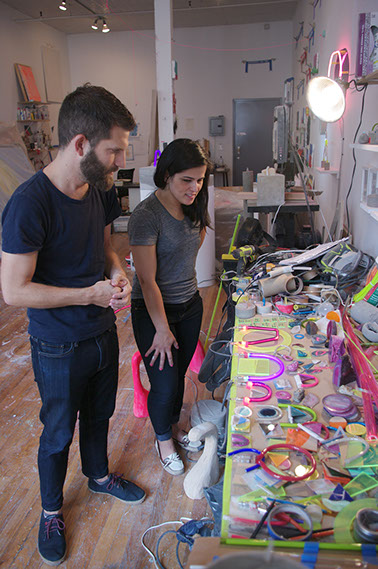
that there are broken ones that you feel the need to un-break through drawing. It makes a lot of sense to me.
Would you ever consider showing the broken ones? Would that kill your soul a little bit?
ER: It would. It would really eat at me, but I’ve had people that say “I want to see all of those” and it makes me really uncomfortable, but I could see it being a thing. These are all failures but. . .
ME: Which together makes some kind of success maybe.
What is your studio practice like? Does being in a shared space affect things?
ER: It’s funny, I’ve been in maybe 4-5 studios since living in New York and my first studio was a very small private studio to myself. And then I shared one. And then I had one that was semi-mine. I shared it with someone I worked for, but I was always there alone. And now I’m here with three others and I’m just learning things about the way I work. At first I was super excited to be with friends, but now I’m learning that I only get real work —work that I’m happy with— when I’m alone and completely isolated.
ME: Is the studio only for work? Or is it a social space?
ER: It’s funny because my studio mates are like “yeah we’re going to party it’s going to be awesome” and when everyone else is here we’re like, “lets drink and hang out”. And it bugs me because I’m only here to work. But I’ll sit at my desk sometimes and waste hours on my phone.
ME: Are they going to be mad when they hear this? Do you need to say something nice about them now?
ER: (laughter) No, I love them! I totally love them, and I love being in here and hanging out with them and just talking about art and what we’re doing but…
ME: It’s hard to get.
Sculpture in studio of Esther Ruiz
Photo: Scott Robinson 2014
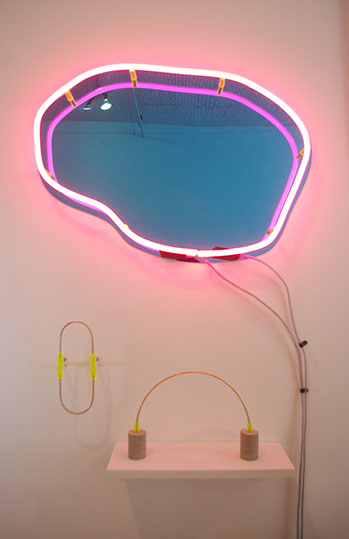
ER: Yeah, it’s hard to get work done. But we’re also really big supporters of one another. I’ll be in here with Renee Delosh and be like “I need an extra hand, get over here!” and she’ll run over. And I’m like, “this concrete’s wet, I need your help right now.” It’s really great. And we’re always talking to one another and talking out ideas so that’s really cool. I didn’t have that before so it’s nice to have a sounding board for ideas.
ME: Yeah, I’m sure. When you’re working, what are the things that make you feel most confident? When do you know ‘this is going well’?
ER: I rarely feel like that.
ME: Let me say, I think you’re doing a great job. (laughter)
ER: Thank you. But it’s a battle. It’s a constant battle. I hate everything I’ve made. I think “this sucks” and I beat myself up all the time – yeah it’s hard. There are times when I’m pouring something and I’m like “yes, everything’s level!” But I’m always finding ways I could make things better or that something could be a bit smoother. But when I’m pouring, I sit on a basketball and zen out while the concrete dries. When it’s drying and looks really level I’m like “yes!” and I feel good.
ME: I think it’s important to know that the basketball you sit on is from Dave and Buster’s.
ER: Oh my god, I love Dave and Buster’s! I spent all of last summer getting tickets, 2500 tickets for that.
ME: I know nothing about Dave and Busters except it is in the mall near my parents in suburban Maryland.
ER: Oh my god you have to go!
ME: Dave and Buster’s is where we should have started. It’s like the 2014 version of Vegas. It’s like a personal Vegas.
ER: Yeah, but it’s also wholesome in a way because you’re just playing games. They have alcohol so it’s like a grown-up Chuck E Cheese —which I love— but I feel like it’s also wholesome because it’s like “we’re going to play games and have fun” and it’s so just like me.
ME: When you’re in here and something doesn’t go as well as you wanted, do you get knocked off your game? Do you recover easily?
ER: I’m pretty resilient. I get super upset and I’ll just curse a lot and I just have to leave and be like fuck this. I like to destroy things also. But then I like to have them around like “those are all awful”.
ME: So it’s a reminder of the bad times?
ER: Yeah, it’s also humbling. They can’t always be perfect.
ME: It’s interesting also that you’ve been working on this geode stuff. It seem like these are all new. Have they been in the work before?
ER: They have. I have a few things out right now. But when I was at Wayfarers I made a few larger ones, medium-sized ones I guess, that had giant geodes with one piece of plexi behind it. And those were the first ones with the geodes.
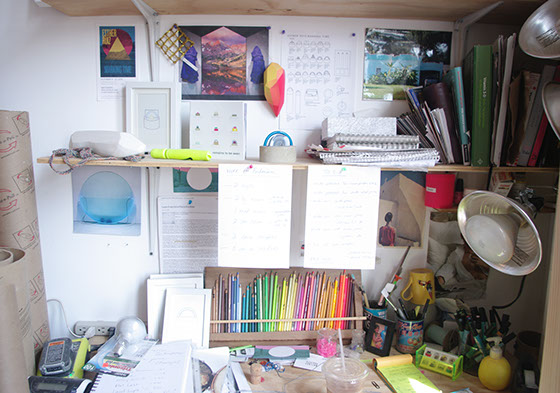
Sculptures in studio of Esther Ruiz
Photo: Scott Robinson 2014
ME: They stand out because they’re symmetrical, but not perfectly symmetrical. They’re sort of organic. Seeing the Plexiglas ones and the geode ones simultaneously is clever because it’s two sides of the same coin.
ER: Right, yeah. I feel like those are naturally geometric in a way.
ME: I don’t know if you saw the Sigmar Polke show at MOMA…
ER: I did.
ME: The last piece he did —I think in his life— was this big geode stained-glass window that he was asked to do for church in Zurich. Your work makes me think a lot about that. The geodes were a stand-in for stained glass and I feel like in a way they’re a stand-in for Plexiglas here.
ER: Hmm, yeah.
ME: One thing I’m wondering… I saw you mention in another interview the famous letter that Sol LeWitt wrote to Eva Hesse.
ER: It’s on my desk. When I was in my first studio, I had no idea what I was doing. I would just sit at my desk and think, “I don’t know what I’m doing”. I would read that letter over and over again and if I ever came to the studio and didn’t know what to do, I’d read that letter. I still read it every once in a while.
ME: It’s amazing. It’s amazing how generous he is in that letter to her and how ‘mentory’. At the time, maybe you wouldn’t think Sol Lewitt would have the time-of-day for Eva Hesse.
ER: I felt the same way, it is amazing. But I feel like there’s something really special about what she was doing because so many people respected her—especially since her death… She didn’t really make that much work, but she’s so well respected and well spoken about. I feel like she was doing something really special at the time. Really, she was genuinely exploring the material. She just seemed so genuine about it and there’s something that I like about that… She’s great.
ME: There are a lot of visible women sculptors right now like Isa Genzken, Jessica Stockholder, and to an extent Phyllida Barlow. I’m wondering if as you make these concrete things that speak with a minimalist aesthetic, that are having conversations with the history of minimalism, does it strike you that there aren’t many women in the minimalist cannon?
ER: I’m definitely looking at minimalist work and I love all those guys like (Dan) Flavin and Sol Lewitt. But it’s funny, it’s only recently been brought to my attention that “you’re a female making minimal sculptures”. I never thought that my gender had anything to do with the things I made and it never occurred to me that that was something people thought about, or that it affected the work, or the way that one perceives the work, or looks at it. Recently –I think I was in a show with only other men and— someone said something like, “oh you’re the only girl, what do you have to say about that” and I was like “Oh, I hadn’t noticed.”
I don’t know what to say about it except I’m just making the things I want to make, and that’s not really something I think about.
ME: I think it’s okay to be a person who isn’t like, “I’m flying the flag for this.” I think that’s okay and I think that’s authentic.
ER: I really don’t know what to say about it. I have met many great female artists that are around right now like Davina Semo and EJ Hauser. They’re great. And I’ve met other great female artists. But I don’t know. I don’t carry that with me.
ME: I think we all bring parts of our identity and parts of our identity are on showcase with the work and it doesn’t have to be necessarily an ambassadorship, like you are not necessarily one representing many.
ER: Yeah, and I don’t think that gender should have anything to do with it. It’s about the work for me.
ME: It’s tricky.
ER: I don’t know what to say about it. Like…
ME: It’s tricky. It’s really tricky.
ER: I want there to be more female artists shown and… Yeah, I don’t know.
ME: No, but I think something really key that you said is that you aren’t like “I am a female artist taking on the legacy of these things.” You are just you, working.
ER: Yeah and I would hope that it doesn’t matter at the end of the day.
Esther Ruiz is an artist living and working in Brooklyn, NY. Current and upcomng shows include:
Landscape with Devices: Noah Dolberg, Esther Ruiz, Phillip Stearns, Fridman Gallery, 287 Spring Street, New York, closing reception Thursday, September 4th, 6-8pm
Two River, Curated by Tamara Gonzales, One River Gallery, 49 N. Dean Street, Englewood, New Jersey, opening reception Saturday, September 6th, 7-9PM, through November 1
Tiger Strikes Astroid Los Angeles Inaugural Exhibition: Your Attica On The Pacific, TSALA Gallery, 440 South Broadway, Los Angeles, CA, through October
Mark Joshua Epstein is an artist based in Brooklyn and Mexico City with a practice based primarily in painting, drawing and collage.
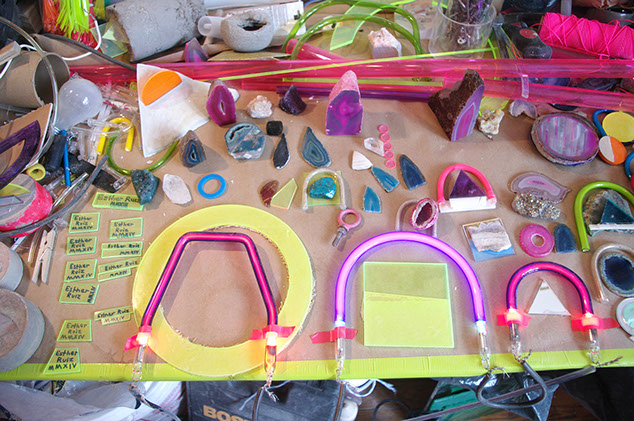
Table top in studio of Esther Ruiz
Photo: Scott Robinson 2014
Disclaimer: All views and opinions expressed are those of the authors and do not necessarily reflect the views of the editors, owner, advertisers, other writers or anyone else associated with PAINTING IS DEAD.

